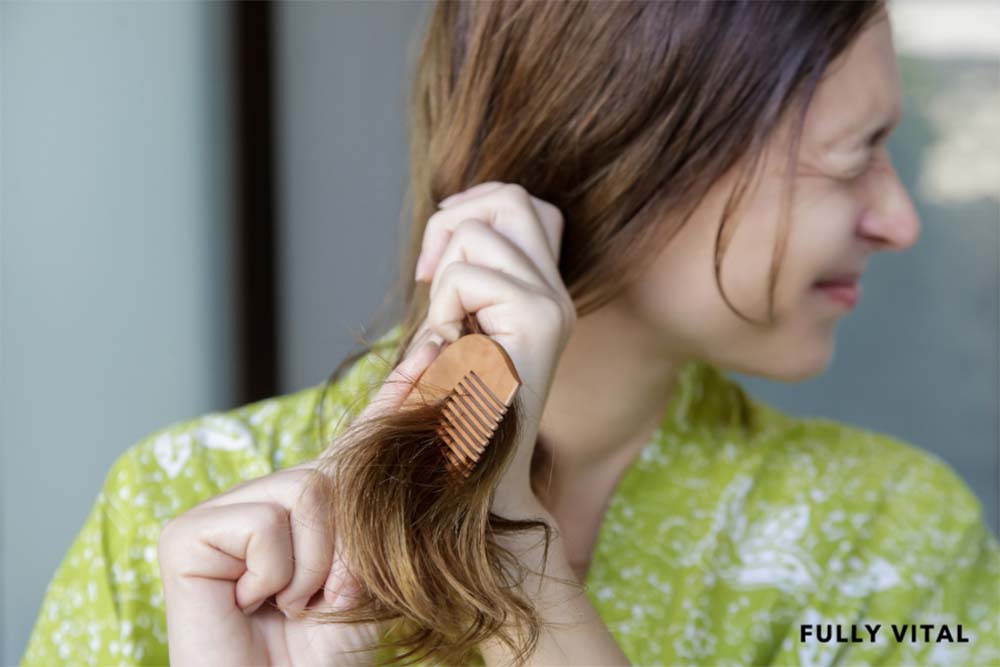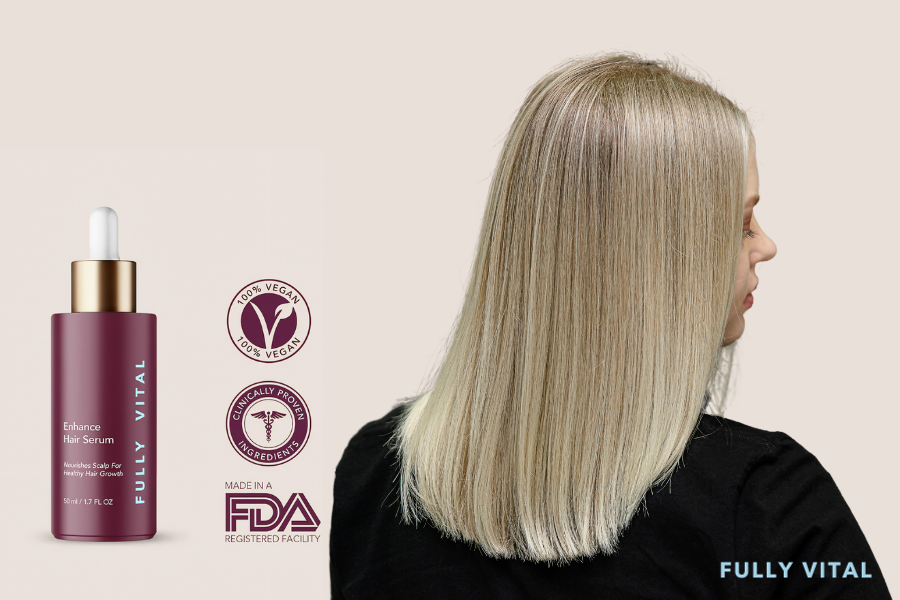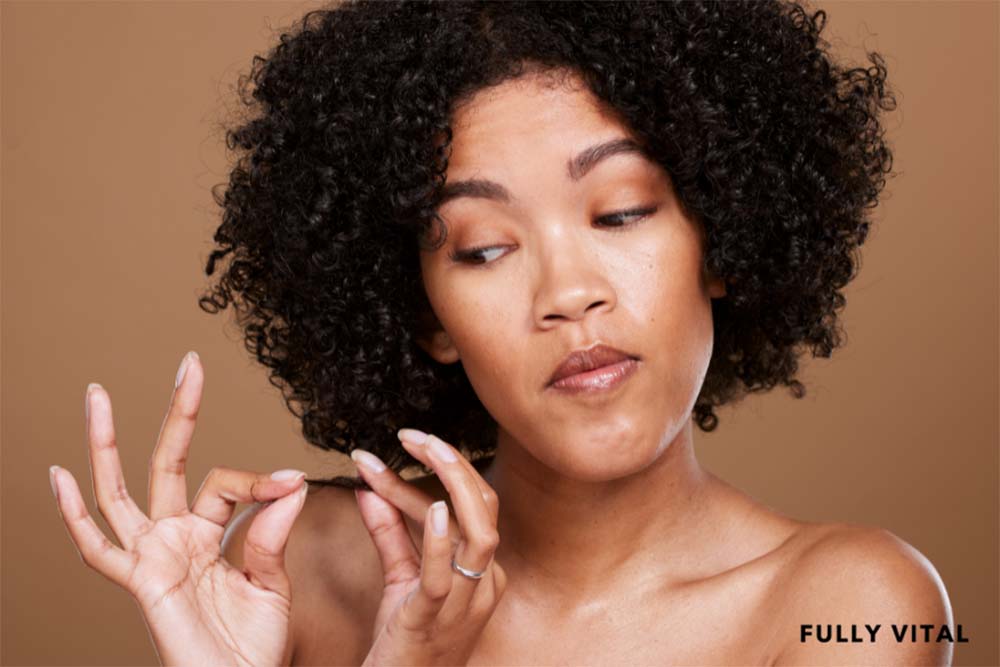
Tangled Hair: Everything You Need To Know
In the quest for luscious locks, tangled hair can often be a formidable adversary.
Whether you have straight, curly, or wavy hair, the battle against knots and tangles is a universal hair woe.
In this article, we'll delve into the intricacies of tangled hair, explore its importance, benefits, and downsides, and even discuss alternative solutions to keep your mane manageable.
So, if you're a woman seeking to stimulate hair growth and conquer the tangle, read on.

I LOVE MY HAIR NOW
FullyVital hair serum and hair vitamins made tremendous improvements in my hair. I truly love my hair now.
Dorit S.,
What Is Tangled Hair?
Tangled hair refers to the condition where strands of hair become twisted, knotted, or intertwined with each other.
These knots can occur at any length of hair and can be a source of frustration for many.1

Why Is Understanding Tangled Hair Important?
Understanding tangled hair is crucial for maintaining the overall health and appearance of your hair.
It can help you prevent damage, breakage, and hair loss, ensuring that your locks remain beautiful and vibrant.
How Does Tangled Hair Develop?
Tangled hair develops when the hair shafts become interlocked, forming knots or snarls.
This can happen due to a lack of moisture, excessive use of heated styling tools, exposure to harsh weather conditions, or neglecting regular hair maintenance.
What Are The Benefits Of Tangled Hair?
While tangled hair might seem like a haircare nightmare, it does have some surprising benefits:
- Natural Volume: Tangled hair often appears fuller and voluminous.
- Texture: It can enhance the texture of your hair, adding character and depth.
Are There Any Downsides To Tangled Hair?
Of course, there are downsides to tangled hair as well:
- Breakage: Tangled hair is more prone to breakage and split ends.
- Difficulty Styling: Styling tangled hair can be a time-consuming task.
- Painful Detangling: Untangling knots can sometimes be painful and cause discomfort.
What Are The Alternatives To Tangled Hair Management?
Managing tangled hair is essential for its health and appearance.
Here are some alternatives to consider:
Regular Conditioning
Using a good conditioner can help keep your hair soft and manageable.
Detangling Products
Invest in detangling sprays or serums to make the process easier.
Gentle Combing
Use a wide-toothed comb or a detangling brush to avoid breakage.
Protective Hairstyles
Braids, buns, and updos can prevent tangling during sleep or physical activity.
Trimming
Regular trims can remove damaged ends and reduce tangling.
Why Is My Hair So Frizzy And Tangled?
If you're wondering why your hair seems to be in a constant battle with frizz and tangles, you're not alone.
Let's explore the reasons behind this common hair concern and how to manage it effectively.
Lack of Moisture
Dry hair is more prone to frizz and tangling.
Insufficient moisture can make your hair cuticles rough, leading to frizz.
Humidity
High humidity levels can cause hair to absorb moisture from the air, causing it to swell and become frizzy.2
Damage
Damage to the hair shaft, such as split ends and rough cuticles, can result in increased frizz and tangling.3
Hair Type
Some hair types are naturally more prone to frizz and tangles due to their texture and structure.
Is Tangled Hair Damaged?
Tangled hair doesn't necessarily mean damaged hair, but it can lead to damage if not managed properly.
Let's explore the relationship between tangled hair and hair health.
Understanding Tangled Hair and Damage:
- Tangled hair can lead to hair breakage if not handled gently during detangling.
- Frequent tangling may cause split ends and weaken the hair shaft.
- Tangled hair can also indicate dryness, which can lead to damage over time.
How to Prevent Damage from Tangled Hair:
- Proper Detangling: Use a wide-tooth comb or detangling brush to minimize breakage.
- Regular Trims: Trim your hair regularly to remove split ends and maintain overall hair health.
- Deep Conditioning: Use deep conditioning treatments to keep your hair moisturized.
- Gentle Handling: Be gentle when dealing with tangled hair to avoid unnecessary stress on the strands.
Should You Shampoo Tangled Hair?
Shampooing tangled hair presents a nuanced challenge that requires careful consideration.
It's essential to approach this task with a mindful strategy to ensure your hair's health and manageability.
Here are some key factors to ponder when deciding whether to shampoo tangled hair:
- Preparation with Detangling Conditioner: Prior to shampooing, it's highly advisable to prepare your tangled locks with a detangling conditioner. This preparatory step serves a crucial purpose: it softens and loosens the knots and tangles, making the subsequent combing process considerably more manageable. By using a high-quality detangling conditioner, you're setting the stage for a smoother, less hair-damaging shampooing experience.
- Opt for a Gentle Shampoo: When it comes to selecting the shampoo for your tangled hair, opt for a gentle, sulfate-free formula. Unlike harsher shampoos, which can strip the hair of its natural oils and exacerbate tangles, sulfate-free options are designed to cleanse without over-drying or causing undue friction. This gentle approach is essential for maintaining the integrity of your hair while addressing the issue of tangling.
- Practice Gentle Shampooing Techniques: As you start on the shampooing process, remember the importance of gentle handling. Avoid aggressive scrubbing or rubbing, as these actions can worsen tangles and potentially lead to more damage. Instead, use a soft, massaging motion to cleanse your hair while being mindful of the knots. By approaching the shampooing process with care and gentleness, you minimize the risk of aggravating existing tangles.
Is Combing Tangled Hair Bad?
Combing tangled hair can be beneficial if done correctly.
Here's how to approach it:
- Start from the Tips: Begin combing from the tips of your hair and work your way up to the roots to avoid excessive pulling.
- Use a Wide-Tooth Comb: Opt for a wide-tooth comb or a specialized detangling brush to minimize damage.
- Apply Conditioner: Apply a leave-in conditioner or detangling spray to make combing smoother.
How Do You Get Rid Of Tangled Hair?
Getting rid of tangled hair requires patience and the right approach.
Here's a step-by-step guide:
- Apply a Detangling Product: Start by applying a detangling spray or conditioner to soften and loosen the knots.
- Divide and Conquer: Divide your hair into small sections to make the process more manageable.
- Use a Wide-Tooth Comb: Gently comb through each section from the tips to the roots.
- Work Slowly: Take your time and be patient, especially with stubborn tangles.
- Post-Combing Care: After detangling, follow up with a nourishing hair mask or conditioner to restore moisture.
- Prevention: To prevent future tangles, adopt a hair care routine that includes regular conditioning and protective hairstyles.
Unlock the Secret To Youthful, Vibrant Hair With Fully VitalDiscover the power of Fully Vital's science-backed hair growth products and embark on a journey to rejuvenate your locks.
Invest in your hair's future with Fully Vital, and rediscover the beauty of youthful, lustrous locks. |
Final Thoughts On Tangled Hair
Understanding and effectively managing tangled hair is a crucial step on your journey to healthier, more vibrant locks.
Tangled hair, while common, doesn't have to be a constant source of frustration.
By following the tips and techniques outlined in this article, you can enjoy smoother, more manageable hair while promoting hair growth and overall hair health.
At Fully Vital, we're committed to helping you nurture a healthier relationship with your hair.
Our range of hair growth products is designed to combat the signs of aging, ensuring that your locks stay youthful and vibrant.
Whether it's preventing tangled hair or promoting hair growth, we have the solutions you need to achieve the beautiful, lustrous hair you deserve.
Remember, your hair deserves the best care, and Fully Vital is here to support you every step of the way.
Embrace the journey to healthier, more manageable hair, and let your locks shine with vitality.
Frequently Asked Questions About Tangled Hair
Can tangled hair lead to hair loss?
Tangled hair itself is unlikely to cause hair loss, but excessive pulling and tugging during detangling can lead to hair breakage.
How often should I detangle my hair?
The frequency of detangling depends on your hair type.
Curly hair may require more frequent detangling, while straight hair can go longer between sessions.
Are there natural remedies for tangled hair?
Yes, some natural oils like coconut oil and argan oil can help moisturize and detangle hair.
Can tangled hair be a sign of an underlying health issue?
In some cases, persistent tangling could be a sign of underlying health problems like nutritional deficiencies or hormonal imbalances.
Consult a healthcare professional if you're concerned.
Is it okay to use a leave-in conditioner for tangled hair?
Absolutely! Leave-in conditioners can provide continuous hydration and make detangling easier.
Can tangled hair lead to scalp issues?
Yes, persistent tangled hair can contribute to scalp issues.
When hair is constantly tangled, it can create tension on the scalp, potentially leading to discomfort and issues like scalp irritation or dandruff.
Proper detangling and hair care can help alleviate these problems.
Are there special brushes or combs for tangled hair?
Yes, there are specialized brushes and combs designed for tangled hair.
Look for brushes with flexible bristles or combs with wide teeth to help minimize breakage while detangling.
These tools are designed to work through knots and tangles with less pulling and damage.
Can tangled hair cause hair thinning?
Tangled hair itself may not directly cause hair thinning, but if not managed properly, it can lead to hair breakage and split ends, which can make the hair appear thinner.
Maintaining healthy hair through proper care and regular trims can help prevent thinning.
Is there a connection between tangled hair and hair growth?
While tangled hair doesn't directly affect hair growth, it can indirectly impact it.
Tangled hair that leads to breakage can result in slower hair growth due to the loss of hair length.
To promote hair growth, focus on managing tangles to minimize breakage and maintain healthy hair.
Are there hair care products specifically for tangled hair?
Yes, there are hair care products formulated to address tangled hair.
Look for leave-in conditioners, detangling sprays, and serums designed to make managing tangled hair easier.
These products can help reduce friction and make combing or brushing smoother.
Sources:
- Knots in Your Hair: Causes, Treatment, Prevention, and Products. (2019, September 20). Healthline. https://www.healthline.com/health/knots-in-hair
- What Causes Frizzy Hair? We Have the Answers. (2021, June 3). Healthline. https://www.healthline.com/health/beauty-skin-care/what-causes-frizzy-hair
- Gavazzoni Dias, M. F. (2015). Hair cosmetics: An overview. International Journal of Trichology, 7(1), 2. https://doi.org/10.4103/0974-7753.153450







